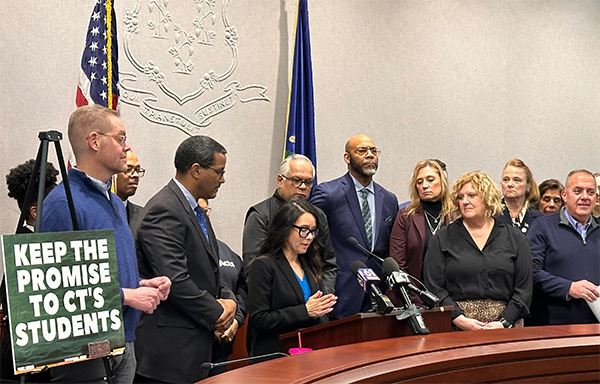Past Accomplishments
Throughout our history, we have worked to ensure all Connecticut students receive equitable education funding that supports their learning needs and provides them with opportunities to succeed inside and outside of the classroom.
We have secured an additional $770 million in need-based funding for Connecticut's public school students, directly engaged over 15,000 community members, and help lead the reform — and full funding — of Connecticut's main education funding formula. Scroll to learn more about these accomplishments and others we've achieved.
We achieved a momentous accomplishment in 2025 when Connecticut's main education funding formula — the Education Cost Sharing (ECS) grant — was fully funded for the first time in state history. After decades of waiting, historically underfunded school districts will now receive their fully funded ECS grant amounts each year — delivering the funding, resources, and opportunities that hundreds of thousands of students had previously been denied.
This achievement comes after we worked with legislators in 2023 to accelerate full funding of the ECS grant and deliver hundreds of millions of dollars to local public school districts faster than previously scheduled. As a result of our advocacy and policy work, we were able to speed up full funding of the ECS grant by two years — from fiscal year 2028 to fiscal year 2026.
Originally, the ECS grant was to be phased in over time (starting with the 2018-19 school year) with historically underfunded districts not scheduled to receive their fully funded grant amount until the 2027-28 school year. This meant students who were in kindergarten when the ECS grant phase-in schedule began would not receive the full, equitable state education funding they were entitled to until they were in high school. Instead, these students and their school districts only received a portion of the funds the ECS formula said they needed.
During the 2023 legislative session, we led the effort to accelerate the phase-in schedule of the ECS grant and ensure students across Connecticut received the full amount of funding they are entitled to. Because of our work and advocacy, the ECS grant's phase-in schedule was sped up by two years and the grant was fully funded — for the first time in state history — for the 2025-26 school year.

In 2024 we scored a landmark victory when the Connecticut General Assembly passed landmark legislation that — for the first time in state history — funds all public school students based on their individual learning needs, no matter where they live or the type of public school they attend.
For years, only the Education Cost Sharing (ECS) formula, which is used to fund local and regional public school districts, took student learning needs into consideration.
As a result, thousands of Connecticut students who attend other types of public schools were not funded by a formula that accounted for their learning needs. Instead, these students, who are disproportionately students of color, were funded through flat-dollar grants.
Through our work with legislators and our advocacy efforts, we accomplished a historic achievement that not only increases funding for students, but helps untangle the state's disjointed and inequitable web of education funding formulas by putting Connecticut on the path for a single, transparent formula to support both local and regional public school districts as well as public schools of choice.

During the 2023 legislative session, our team led the charge for a historic investment in Connecticut's students, schools, and communities. Through our advocacy, data and policy work, and community engagement efforts, we secured an additional $150 million for Connecticut public schools in fiscal year 2025. This is the largest single investment in K-12 education in Connecticut in the past 10 years, and the second largest investment in state history.
To make this historic investment a reality, we worked collaboratively with legislative leadership and policymakers on both sides of the aisle; engaged and activated superintendents, teachers, municipal leaders, and board of education members; and developed and executed a successful media campaign to draw attention to the need for greater education funding.
Our Community Engagement team also activated parents and stakeholders from around the state to urge their legislators and the governor to invest in Connecticut's public schools. As a result of our community engagement efforts, 465 pieces of legislative testimony were submitted, and hundreds of emails were sent to legislators and the governor, in support of greater, more equitable education funding.

Since our founding, one of our primary goals has been to improve Connecticut’s education finance system for all students and communities by creating a more equitable, logical, and transparent system. Throughout the Connecticut General Assembly’s 2017 legislative sessions, we worked with the Office of the Governor and all four legislative caucuses to revise the state’s Education Cost Sharing (ECS) formula, which is the primary way Connecticut distributes state education funding to local public school districts.
Our work for a more equitable funding formula included modeling dozens of potential revisions to determine their impacts on the state budget and individual towns. Our staff also consistently met and communicated with legislators about the need for a new, equitable ECS formula, and created talking points and presentations for lawmakers to use.
Through our work and the technical assistance we provided to the Office of the Governor and the General Assembly, our team helped spark the conversation that ultimately resulted in the legislature passing a new, more equitable ECS formula as part of the state’s biennial budget. As a result of the new formula, local public school districts, for the first time in years, are now funded more equitably and receive state education aid based on the needs of their students and communities rather than through arbitrary and political block grants.

We worked with legislative and education leaders to pass legislation in 2024 that caps the amount of tuition school choice operators may charge local school districts — saving districts nearly $40 million annually.
Tuition for students attending out-of-district public schools of choice has long been a volatile budget line item for school districts and municipalities, and has frequently been the source of confusion and conflict.
That's why our team led the effort to limit how much local school districts could be charged for resident students who elect to attend to an out-of-district magnet school or AgriScience program, all while adequately and sustainably supporting these public school choice options.
Beginning in fiscal year 2025, the per-student tuition amount an operator of a magnet school or AgriScience program may charge is capped at 58% of the per-student tuition amount the operator charged in FY 2024. The State of Connecticut will pay the difference to magnet school and AgriScience program operators so they will be held harmless.
As a result of this cap, districts paying tuition will experience savings due to lower tuition costs and be able to keep those dollars in their classrooms and put them to use supporting students, educators, and essential programs and services.
School districts are estimated to save a combined $39.1 million in tuition costs in FY 2025 as a result of the cap. Approximately $29.3 million (75%) of the total savings will be realized by Alliance Districts — the state’s lowest-performing districts.

Previously, Connecticut did not provide state funding to school districts for minor repairs and capital improvements. Instead, the cost of these projects fell entirely on local taxpayers. That changed in 2025 when we developed the District Repair and Improvement Project (DRIP) program and secured its legislative passage.
The DRIP program helps ensure safer, healthier learning environments for students and educators by providing reimbursement grants to school districts for minor capital repairs and improvements to public school buildings, grounds, and infrastructure that are not large enough to qualify under the state's existing school construction program.
Prior to the creation of the DRIP program, municipal budget constraints and the lack of state funding meant these minor projects were frequently deferred or eliminated — leading to unsafe, unhealthy, and deteriorating school facilities that eventually required major, more costly renovations.
By working with legislators, school district leaders, and municipal officials, we were able to enact the DRIP program, secure $30 million in both fiscal years 2026 and 2027 to fund the program, and establish a dedicated, annual stream of state funding to support the minor capital repairs and renovations school districts often need.

Agricultural Science and Technology Education (AgriScience or ASTE) programs are an important piece of the public school choice options offered to Connecticut's students. In 2024 we successfully passed legislation expanding student access to AgriScience programs and ensuring these programs receive the funding they're entitled to.
For years, Connecticut had a statutory cap in place that limited the number of students an AgriScience program may enroll. The purpose of this cap was to limit the potential financial impact to local public school districts who would be responsible for paying tuition to AgriScience programs for each of their resident students who elected to attend the program.
As a result, students who were eligible and wanted to attend an AgriScience program were sometimes denied due to the cap, and AgriScience programs that wanted to expand their enrollment and offerings were not able to do so.
These issues were resolved, however, in 2024 when we worked to pass a cap on the tuition AgriScience programs and magnet schools were able to local school districts. Because the tuition cap limits the financial impact to districts, we were also able to eliminate the cap on how many students an AgriScience program may enroll.
Additionally, we were able to ensure students attending AgriScience programs receive the funding they're entitled to by working with legislative leaders to remove "within available appropriations" language from state statutes so AgriScience program per-student grant amounts cannot be reduced below their full amount ($5,200) should AgriScience enrollment increase beyond the amount appropriated for by the legislature.

Throughout our organization's history, our Community Engagement team has held hundreds meetings and workshops with communities across the state, presented to thousands of individuals, and built a contact list of committed individuals across 80+ cities and towns. Through this work, our organization has built genuine, positive relationships in communities across Connecticut, increased knowledge and engagement around issues of education and state finance, and given people the skills to effectively add their voices to policy discussions
As a result of this engagement work, community members have grown significantly more knowledgeable about how Connecticut funds its public schools and have become more involved in advocating for equitable funding for all students.
These deep relationships and the presence of engaged communities has led us to expand our education offerings and presentations, and we now offer an array of workshops that cover everything from how the economy works and impacts state finance to how to write an Op-Ed or piece of legislative testimony. Additionally, in response to students expressing interest in learning more about education finance, we developed a K-12 curriculum that has been utilized regularly.

From 2010 to 2020, Connecticut’s multilingual learner population grew by nearly 13,000 students while the state's total student enrollment declined significantly. This increase in student need also brought along a need for greater resources to support multilingual learner students, who are also commonly referred to as English Learners or English Language Learners. During the Connecticut General Assembly's 2021 legislative session, we responded to these growing needs by working with legislators and partner organizations to adjust some of the ECS formula's weights and thresholds to drive greater resources to multilingual learner students and economically disadvantaged districts.
The legislature also adopted another one of our recommendations and increased the ECS formula's concentrated poverty weight from 5% to 15% and lowered the eligibility threshold for the weight from 75% to 60%. As a result of these changes, greater funding is provided to districts with high concentrations of economically disadvantaged students, and more districts are eligible for this additional funding.

Navigating Connecticut's state budget is no easy task. At nearly 600 pages long with hundreds of line items and numerous complex statutory changes, the state budget is far from a light read and can easily become overwhelming and confusing. We aimed to fix this by launching a Budget Analysis Tool in September 2019, the first comprehensive, interactive tool designed to help users of all knowledge and skill levels navigate the state budget and better understand how state revenue is raised and spent.
The Budget Analysis Tool allowed users to explore Connecticut's biennial state budget for fiscal years 2020 and 2021 and examine how the state's revenues and expenditures have changed over the years. The interactive tool also gave users the chance to easily find information about agency spending, specific line items, and different revenue streams.
The Tool also highlighted fixed costs in the state budget and offered a look into aid provided to each Connecticut city and town. Stakeholders from across the state, including legislators and local policymakers, found the Budget Analysis Tool useful and a quick and accessible way to find budget information.

Stay Up-to-Date
Sign up to get new reports and the latest data sent right to your inbox